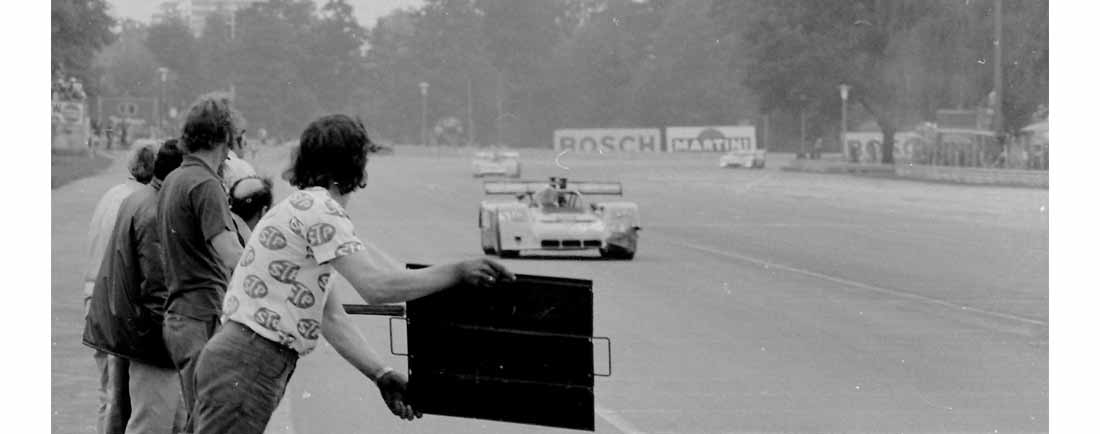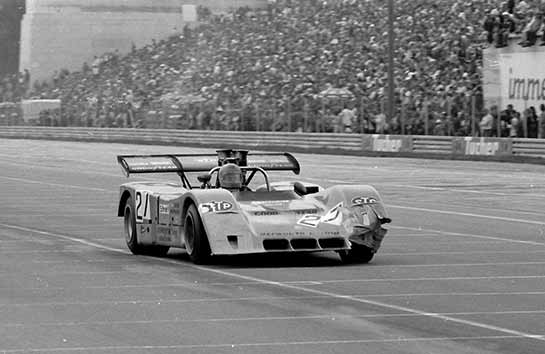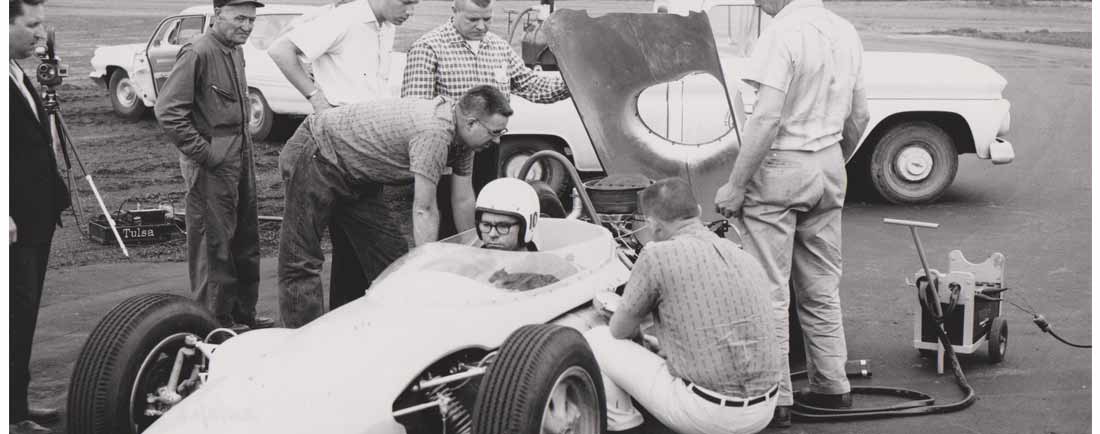
BRM P167 Can-Am
By Ian Wagstaff
First published in http://dailysportscar.com/
My first sight of the BRM P167 Can-Am car had been at Hockenheim in 1971. Having lapped virtually the whole Interserie field, Brian Redman was still sideways round the SudKurve with the chequered flag in sight. I wondered why. “Still hadn’t got the outright lap record,” the Lancastrian said, with a grin.
Two years later, approaching the outskirts of Brussels, I found myself about to take over the wheel of a Bedford van, which had been borrowed by the Hepworth Racing Organisation, for the first time. My experience of towing had previously been limited to a two-wheel trailer carrying a Modsports MG Midget. Now I had the responsibility for that very same BRM. We were taking the car back to Germany but now it was owned by double RAC hillclimb champion David Hepworth, and I was along to help drive the Bedford tow van and polish the wheels.

David had purchased the BRM P154 and P167s (all but one are still owned by the Hepworth family), having first raced one of the earlier cars in 1972. It was at the Silverstone Interserie round the following year, where he was placed sixth, that he wondered if I would like to accompany the team on its next outing. A couple of weeks later I found myself on the grid at the Norisring, looking up at the vast crowd on the former Nazi stadium and feeling a trifle overawed.

Practice for the 200 Meilen von Nürnberg had not gone too well. Taking a hillclimbing line, David had punted Reinhold Jöst’s Porsche 908/3 into the Armco. At least that was Jöst’s take on it. I approached him, wearing my journalist’s hat. On realising that I was English, he threatened to do dire things to my compatriot. I avoided mentioning my link to the team.
It was raining prior to the race. We were hardly the richest team on the grid; those were the Porsche 917/10 owners. “Willie Kausen’s city slickers”, we said. Thus, we had no intermediate tyres and sent David out on wets instead. With the track still wet and to our intense delight, he got up to second place behind Teddy Pilette’s McLaren M8F. Chief mechanic John Brooke turned to me and pointed out that this was the reward for all the hard work put in. Of course, it did not last and as the track dried, David’s tyres wore down to a dangerous level. Still, as his son Stephen recently told me, the Yorkshireman regarded it as his finest hour. Later in the two-heat race, David went off, damaging the BRM’s nose. ‘Brookie’ threw some tape at me as the BRM shot into the pits and told me to work on the driver’s left front corner. It was my first experience of a pit stop – Modsports races never lasted long enough - and I made the proverbial porker’s ear of it. We were eventually classified 13th.
The next month saw us at Hockenheim where David blew up his 8.0-litre Chevrolet V8 in practice and we fitted the smaller 7.6-litre overnight in the paddock. There was nothing new in this. We had also changed engines the night before the Norisring, but then we had been in a garage. I say ‘we’ but all I did was hand out spanners. Still, on coming across the Autosport report of the race, I was proud to see the overnight efforts of Hepworth’s little team (there were three of us) were praised in print. The new engine lasted a mere three laps. Disconsolate, I wandered off to take some photos from the infield where my press pass had allowed me on the previous visit. The marshal there seemed to think my mechanic’s armband insufficient.
I once calculated how much sleep we had over the course of those two events from the time we left David’s base in Brighouse to the time we returned. I reckon it averaged out at about two hours a night. I recall waking up early one morning to find ourselves, van, trailer and BRM, parked on the hard shoulder of the M1 motorway. ‘Brookie’ had become so tired that he had pulled over and, unable to wake either me or his assistant, had just dropped off to sleep himself.

Having said that, we did stay in Germany for an extra night after Hockenheim, having been invited to a beer festival by Helmut Kelleners’ British mechanics. No mobile phones in those days and not getting back on time, I had to stand up a girl I had met at a party the week before. Perhaps she should have got the message, but we are still married.

Above (left to right): John Brook, Stephen Hepworth, Ian Wagstaff, Andrew Hepworth
(In 2015, David’s sons Stephen and Andrew restored the car before taking it to the Goodwood Festival of Speed. ‘Brookie’ flew from Canada to be present, while I wallowed in nostalgia.)
The first, Tony Southgate designed BRM Can-Ams, the P154s had been built and taken to the USA by Roger Bailey and Mike Underwood (Mike already had experience there as a Lotus mechanic at Indianapolis, but this was Roger’s first involvement. He once told me, “America did not appeal to me” but he went on to become a major player there.) George Eaton raced one of them in the 1970 Can-Am Challenge, being joined later in the season by Pedro Rodriguez. The best they achieved was a pair of thirds.
The design was reworked, as the P167, for the following season with a shovel nose and separate rear wing. Rodriguez told Southgate that the P154 was the worst car that he had ever driven. He therefore completely redesigned it with about an additional nine inches in the wheelbase. The result, recalls Howden Ganley, “Was absolutely magic. The thing was so easy to drive in the rain, just a little bit of wheel spin in top gear. It was fantastic at Riverside (where it used one of McLaren’s engines). At the Nürburgring 300kms in 1972, the Porsche 917/10 turbos turned up but I won both the two heats by over a minute.”
Brian Redman achieved a couple of wins with the P167 in the Interserie before it was shipped off the States, where it was driven by Ganley and then Redman again. In 1972 it was back to Interserie racing with a couple of more wins for Ganley and one for Helmut Marko.
Howden remembers how the P167 had to take second place to the Formula One programme, as Eaton was no longer with the team. “BRM always seemed to bite off more than they could chew.” The New Zealander was sent to Snetterton to test it. “I remember going up the very long Norwich straight, hearing a funny noise in the front and realising it did not have much feeling in the steering. I tried half a turn this way and that and it did not make the slightest difference. It had far too much download on the front then and needed stiffer springs. There was a plan for Tony Southgate to come round with me but we were told that was not allowed.”
The car appeared ready for Rodriguez to race at the Norisring but, shortly before, it had an engine problem. The Mexican took a drive in Herbert Müller’s Ferrari 512M, only to suffer a fatal accident during the race. “Then Sid Taylor came and scrounged it off ‘Big Lou’ (BRM’s pompous boss Louis Stanley) and took it to Laguna Seca for Brian,” recalls Howden. Jo Siffert’s death tragically followed shortly on from that of his John Wyer team mate Rodriguez and, as Redman wanted to attend the funeral, Stanley ‘commanded’ Ganley to replace him for the next Can-Am race. He was also planning to go to Siffert’s funeral. “However, I thought what would Jo have done, and he would have gone to Riverside, so I went. Our budget to do the race must have been less than Porsche’s catering.
“Sid would only let me have nine laps practice; I was really pissed off. I qualified well down but eventually finished up on the podium. We were going back to America the following season but then Stanley decided to do Interserie instead.” Ganley, who recalls a third, improved design half finished in the workshop but which came to nothing when the project was canned, was not too amused by that.
All the five BRM Can-Am cars still exist, four of them owned by David’s sons. The exception is the ex-George Eaton chassis P154/1. Included are what is known as ‘the bastard car’, an interim machine with P154 short wheel base but P167 geometry and a pair of P167s. One of these is the, by then mustard coloured, car, which had been thrust into my tender care that day heading into Brussels, and the second chassis that, it is believed, was never completed by the factory but assembled by David following acquisition.
The Can-Am monsters were not BRM’s first sports cars; the Le Mans gas turbine has that honour. If you include the P351/P301, which merely carried the BRM name, they were not the last. However, they were an intriguing interlude in a story of a manufacturer far better known for its Grand Prix cars.
View all books by Ian Wagstaff
Click on the following link for other articles by Ian Wagstaff.






Leave a comment
This site is protected by hCaptcha and the hCaptcha Privacy Policy and Terms of Service apply.